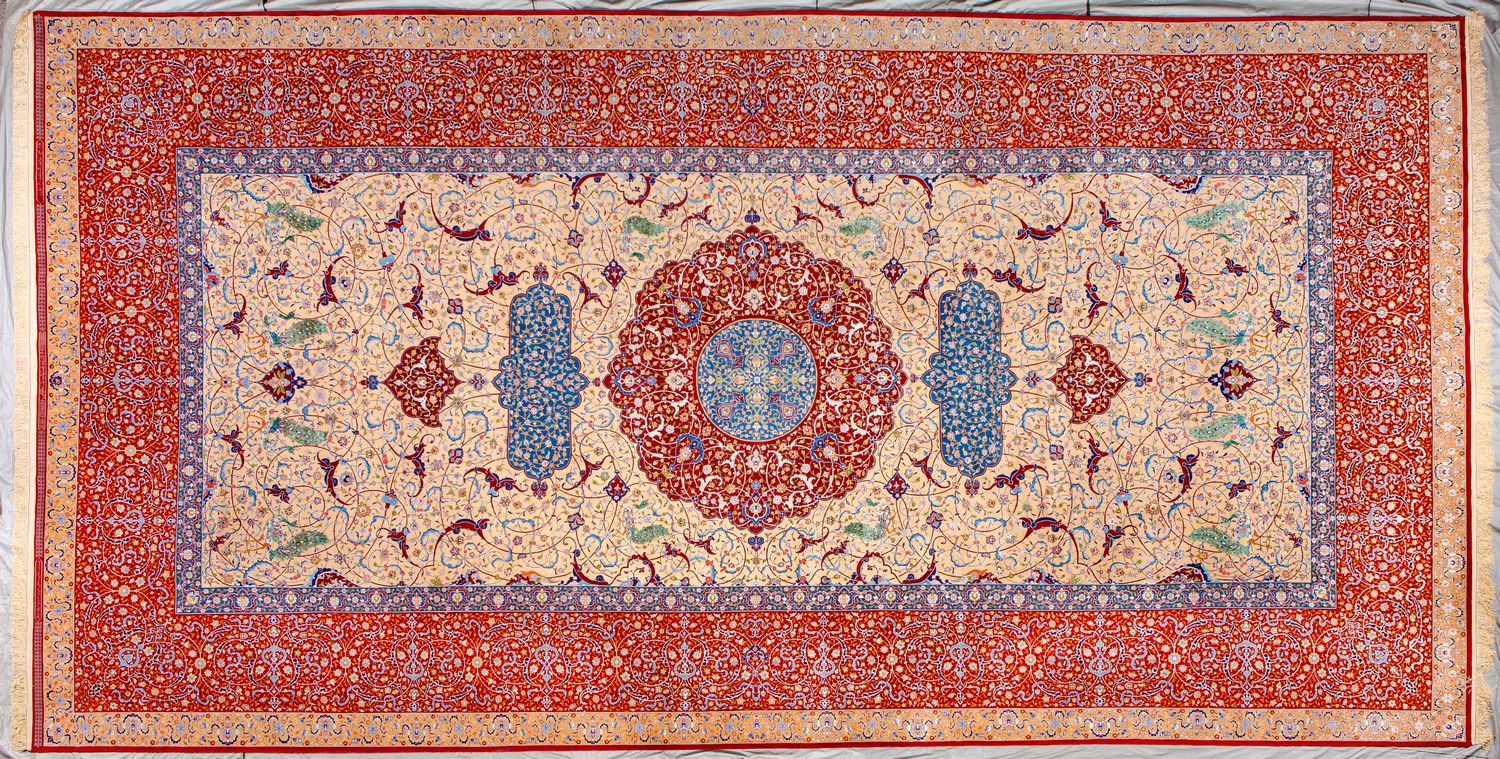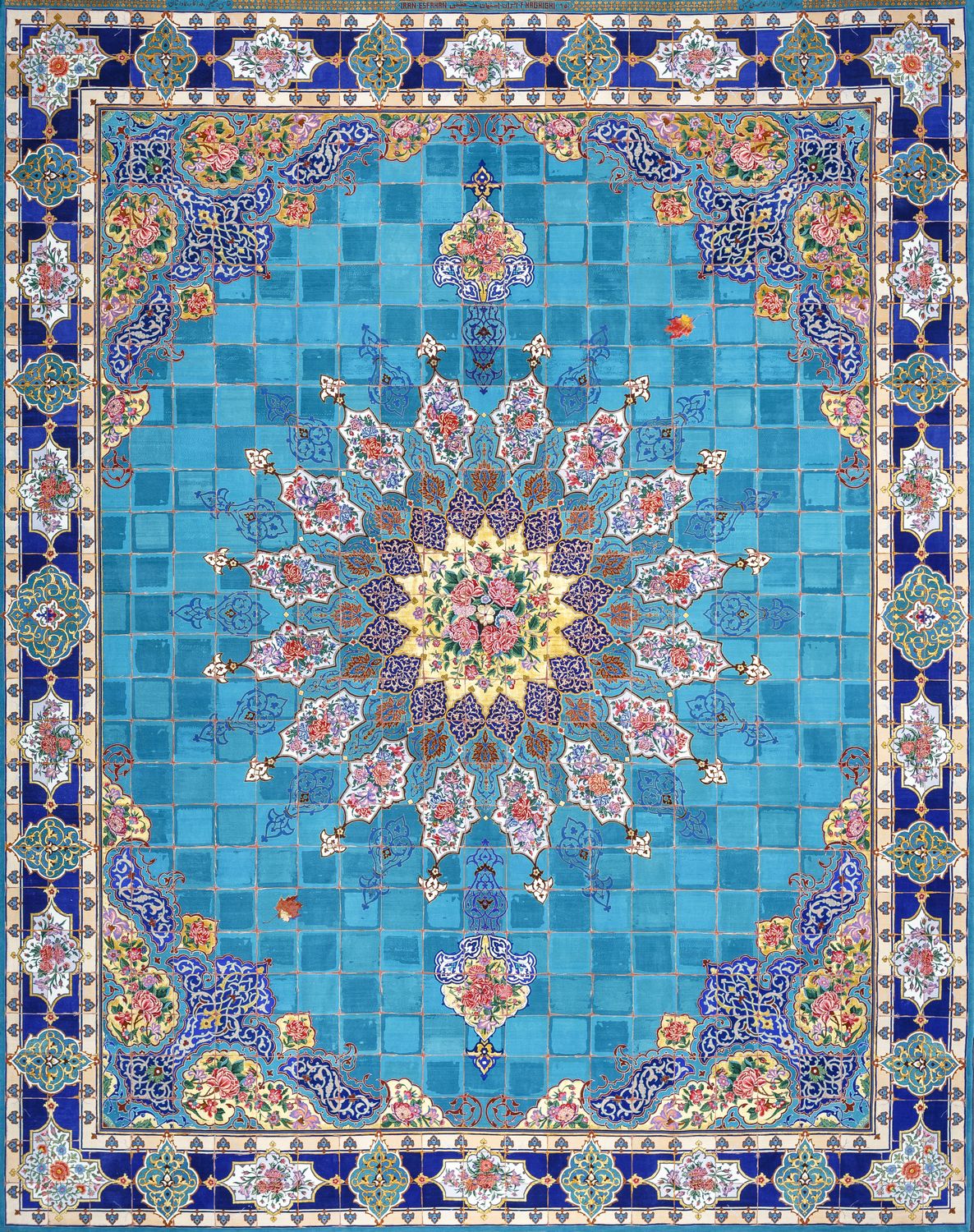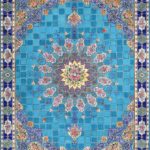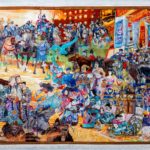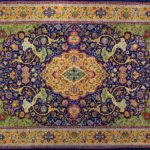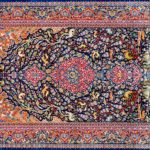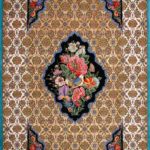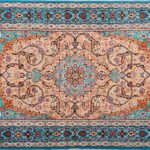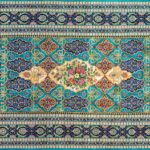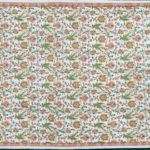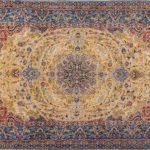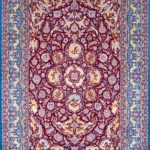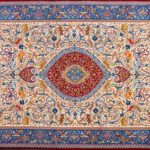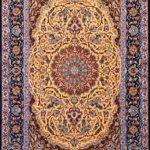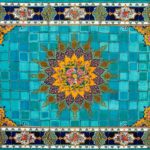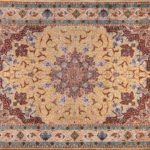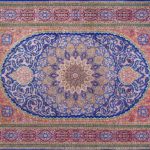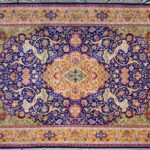The Anhalt Carpet
The Anhalt Carpet was made in the Safavid era in the first half of the 10th century AH/ 16th century AD. This unique carpet was discovered in the second half of the 19th century in Dessau Castle, a seat of the dukes of Anhalt, and was donated to the Metropolitan Museum of Art in New York by Samuel H. Kress in 1946. The carpet was possibly owned by Joseph Devin in London in 1931-1939 before it was sold to Samuel Henry Kress in 1940. However, it is known by the title “Anhalt” as it was previously owned by the Anhalt princes of Dessau. Its unique colors, such as its yellow background—rarely seen in carpets of this type—make it stand out among other Safavid era carpet products. The Anhalt Carpet features a central medallion(Toranj), two dark blue cartouches(Sartoranj) and dark red pendants (Sartoranj), arabesque scrolls ending in Dahan Azhdari motifs, six peacocks in the upper part of the carpet, and six in the lower part.
This carpet was created in the Safavid period, coinciding with a significant transformation in the art of carpet weaving. Tahmasp I, the second ruler of Iran’s Safavid dynasty, established carpet weaving workshops in Tabriz, Kashan, Isfahan, and Kerman. During the rule of Abbas I of Persia, carpet production experienced a dramatic evolution and carpets became a major part of commerce. Shah Abbas forced a part of Julfa’s Armenian population from the coasts of Aras River in the present-day Republic of Azerbaijan to the southern outskirts of Isfahan. As a result, their trade monopoly over silk—an integral commodity in the production of carpets—became a principal source of income for the Safavid government. During this period, floral motifs replaced the figural motifs that were common in royal carpets and textiles in the 10th century AH /16th century AD, and a substantial number of carpets with floral and arabesque designs were produced.
The Anhalt Carpet was also produced in this period. It is a medallion (Toranj) carpet, with a medallion (Toranj) in the centre and two cartouches (Sartoranj). The design of the medallion (Toranj) is very similar to book covers from the Safavid and tiles from the Timurid and Safavid eras. The dark blue cartouche (Sartoranj) is abundantly found in Safavid tile work. Examples of the same design can be seen in the entrance of Harun-i Vilayat Mausoleum (from Shah Ismail I Safavid period in Isfahan), Chehel Sotoun Palace, paintings of Aali Qapu Palace, Tong Bori designs of Aali Qapu Palace’s music room, and numerous other Safavid buildings. The same design is also extensively used by calligraphers as a frame for their calligraphy works. For instance, Mirza Gholam Reza Esfahani, a master of Nastaliq and Shekasteh Nastaliq calligraphy in the Qajar period, used this design as a frame for his works. Snake-like arabesque scrolls (Eslimi) seen in the Anhalt Carpet can also be found in many tiles works from the Timurid and Safavid periods. A good example is the main entrance of Ali Mosque in Isfahan, which was built in the Ismail I era. These examples show the close relation between carpet design, tile work, and book illumination in the Safavid period.
Recreation of Anhalt Carpet (New Anhalt) by Mohammad Mehdi Safdarzadeh Haghighi
After the official export of Iranian carpets since Naser al-Din Shah’s rule, European and American buyers looked for carpets with the same colors as the old Persian carpets. These were exported all over Europe since the rise of the Safavid dynasty, which featured brilliant and captivating colors that fascinated the buyers. This growing demand ushered in a great revolution in the Persian carpet industry that was accompanied by the rise of Amu Oghli brothers focusing on the revival of the carpet industry in Mashhad since 1300 AH. With a clear understanding of the status of Safavid carpets, Abdul Muhamad and Ali Khan Amu Oghli opened a new chapter in the history of Persian carpets. Following the mesmerising design of the Ardabil Carpet, which had been transferred to the Victoria and Albert Museum in London, they created similar carpets in different sizes, approximating even its textures, thus leaving great lessons on the subject of carpet re-weaving for the future. Their focus on the design of the Ardabil Carpet invited the attention of other artists to this field. A remarkable example of this trend is the re-creation of the Anhalt Carpet by Mohammad Mehdi Safdarzadeh Haghighi.
The carpet was recreated in the 397 x 770 cm dimension. The warp thread used in this carpet is made of silk and its weft is cotton. It has 11,600 knots per square decimeter and is woven with asymmetrical knots and was woven by Parvin Daneshvar, Sedigheh Danesh Ghafouri, and Sedigheh Ghadiri. The carpet premiered at the 27th Tehran International Carpet Exhibition, showcasing the result of five years of relentless and artistic endeavour spanning carpet design, colouring, dyeing, and weaving. According to Haghighi, the re-creation of the Anhalt Carpet is a creation of its own time, and the changes in its motifs, arabesque, and color are tailored to the demands of the Iranian society. Therefore, this carpet is not a mere copy of the exquisite ancient work. After recreating the Anhalt Carpet, he is working on re-weaving other prominent historical Persian carpets, which will be unveiled in the near future.
The following is a part of Mohammad Mehdi Safdarzadeh Haghighi’s speech., the creator of the new Anhalt carpet.
“In 2012, I made my first visit to New York and the Metropolitan Museum of art. Stepping through the rooms, a masterpiece of the Safavid era came to my attention. I was in awe of this magnificent piece of art woven so many years ago. The proportions and attention to detail struck me. I was suddenly inspired to re-create this historical rug as a new piece of art. To me, this was a new artistic transition. I wanted to bring this rug back to life. I spent the next six years on the design, color, and weave of this new Anhalt. During the 200th anniversary of HALI magazine in 2019, I realized that professor Walter Denny was giving a talk and the subject was Anhalt. Surprised and excited that someone else was also mesmerized by this historical piece, my dear friend and professional herpetologist Mr. Turaj Zhuleh, knowing how excited I was, sent a note to Mr. Michael Francis on my behalf to contact Professor Walter Denny. In this letter, Professor Denny was told about the coincidence between the topic that he chose and the production that had recently finished in Esfahan. However, to Mr. Francis, this was like a copy of Mona Lisa and Professor Denny no longer had time to include my project in his lecture. Respecting Mr. Francis’s view, my intentions were not to reproduce a copy but to create a piece of art fitting for our times. Re-creating or re-weaving a historical piece of art in my opinion is not creating a fake copy. A fake would be an exact copy of the piece without any changes whatsoever. Although the proportion and size of my Anhalt rug might be the same as the Safavid rug, design-wise I have made substantial changes in the details, for example with broken arabesque lines, flowers, and peacocks.
The artist and producer of this rug created this during his era and I have done so during our era with my own knowledge and experience and 120 years of family background. The old Anhalt through time has become an antique and is rightly placed. My modern Anhalt is an artistic transition with respect for past artists to inspire a new generation of rug designers and producers. In the near future, with regard to this rug, other artists and producers might be motivated to create their own versions in different sizes. On the point of re-creations, 80 years ago the Amoqli family recreated the Sheikh Safi rug and brought it to attention for the first time. Many different Sheikh Safi rugs have been woven since Amoghli’s version and the Amoghli carpet is now also very valuable without devaluing the original Sheikh Safi rug. My Anhalt project is a tribute, with the intention of influencing a new generation to learn and be shaped by the past.
The Safavi Anhalt was first artistically criticized by me in 2012 by a rug and later in 2019 by Professor Walter Denny in his lecture. It is now up to the critics to judge Anhalt in the future”
Negin Al-sadat Tabatabaei
Islamic Archaeology PhD graduate, University of Tehran
